Hercules constellation is located in the northern sky. It was named after Hercules, the Roman version of the Greek hero Heracles.
Heracles, in turn, was often associated with the Sumerian hero Gilgamesh, and the constellation itself has a long history, dating back to Sumerian times.
Hercules is the fifth largest constellation in the sky, but has no first magnitude stars. In traditional depictions, the star Ras Algethi (Alpha Herculis) represents Hercules’ head and a prominent asterism, the Keystone, marks his torso, as he stands victoriously on Draco’s head.
In mythology, the constellation Hercules is usually associated with the penultimate labour of Heracles, which involved defeating the dragon Ladon, who guarded the garden of the Hesperides. The dragon is represented by the constellation Draco. Hercules constellation was first catalogued by the Greek astronomer Ptolemy in the 2nd century.
Notable deep sky objects in Hercules include the Great Globular Cluster (Messier 13), the globular cluster Messier 92, the planetary nebulae Abell 39 and the Turtle Nebula (NGC 6210), the radio galaxy Hercules A, the Hercules Cluster of galaxies, and the galaxy cluster Abell 2199.
Facts, location and map
Hercules is the fifth largest constellation. It occupies an area of 1225 square degrees in the sky. The constellation lies in the third quadrant of the northern hemisphere (NQ3) and can be seen at latitudes between +90° and -50°. The neighboring constellations are Aquila, Boötes, Corona Borealis, Draco, Lyra, Ophiuchus, Sagitta, Serpens Caput and Vulpecula.
The constellation name Hercules is pronounced /ˈhɜːrkjʊliːz/. In English, the constellation is known as Hercules. The genitive form of Hercules, used in star names, is Herculis (pronunciation: /ˈhɜːrkjʊlɪs/). The three-letter abbreviation, adopted by the International Astronomical Union (IAU) in 1922, is Her.
Hercules belongs to the Hercules family of constellations, along with Aquila, Ara, Centaurus, Corona Australis, Corvus, Crater, Crux, Cygnus, Hydra, Lupus, Lyra, Ophiuchus, Sagitta, Scutum, Sextans, Serpens, Triangulum Australe and Vulpecula.
Hercules contains two Messier objects – Messier 13 (M13, NGC 6205) and Messier 92 (M92, NGC 6341) – and has 12 stars with known planets. The brightest star in the constellation is Kornephoros, Beta Herculis, with an apparent magnitude of 2.81. The Tau Herculids are the only meteor shower associated with the constellation.
The constellation contains 14 formally named stars. The star names approved by the International Astronomical Union (IAU) are Bodu, Cujam, Franz, Hunor, Irena, Kornephoros, Maasym, Marsic, Ogma, Pipoltr, Ramus, Rasalgethi, Sarin, and Tusizuo.
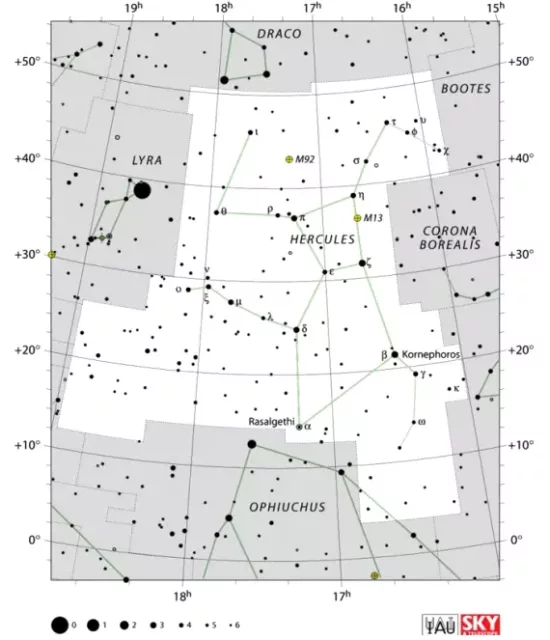
Hercules constellation map by IAU and Sky&Telescope magazine (Roger Sinnott & Rick Fienberg) (CC BY 3.0)
Myth
Hercules constellation dates back to ancient times. Its origin was unclear even to the Greeks. They knew it as Engonasin, or “the kneeling one.” It was Eratosthenes who identified the kneeler as Heracles, standing over the dragon that guarded the garden of the Hesperides.
Aeschylus associated the constellation with a different tale, describing Heracles as kneeling and exhausted after the battle with the Ligurians.
Heracles was the son of Zeus and Alcmene, a mortal woman. When he was an infant, Zeus laid him at Hera’s breast while she slept. Having suckled her milk, Heracles became immortal. Hera was enraged by this and made Heracles’ life difficult at every turn. She cast a spell that made him lose his mind and turn against his children. Once he regained his senses and realized what he had done, he visited the Oracle at Delphi to see how he could atone for his deed. The Oracle sent him to serve Eurystheus, king of Mycenae, for a period of 12 years. It was then that he got the name Heracles, which means “the glory of Hera.” His given name at birth was Alcides, Alcaeus, or Palaemon according to different sources.
King Eurystheus gave Heracles a series of tasks, known as the Labours of Heracles. The first was to defeated the Nemean lion, a beast with an impenetrable skin. After Heracles had strangled the lion, he used its claws to cut off the skin and later used the pelt as a cloak and the gaping mouth as a helmet, which both protected him and made him look even more frightening. The Nemean lion is represented by the constellation Leo.
The second task was to destroy the Hydra, represented by Hydra constellation, a monster with multiple heads. As he fought with the beast, Hera sent a crab to distract him. Heracles did away with the crab, and Hera placed it in the sky as the constellation Cancer.
Heracles was then sent to catch a deer with golden horns and, after that, a ferocious boar. The fifth task was to clean the stables of King Augeias of Elis. The sixth was to do away with a flock of marauding birds, and the seventh, to catch a bull that breathed fire and was ravaging the land on Crete. The eighth labour was to bring the horses of King Diomedes of Thrace, which ate flesh, to Eurystheus. The ninth was to bring the king the belt of Hippolyte, the queen of the Amazons. The tenth labour was to steal the cattle of Geryon, a monster that lived on the island of Erytheia. On his way back, he was confronted by local forces that outnumbered and nearly overcame him. He sank to his knees and prayed to Zeus. The god helped him by sending rocks, which Heracles threw at his adversaries. This is the event that, according to Aeschylus, was commemorated by the constellation Engonasin (the kneeler).
Even though Eurystheus and Heracles had originally agreed on ten tasks, when Heracles came back, the king refused to release him from his service and set two additional tasks. The first was to steal the golden apples from Hera’s garden on Mount Atlas. The garden was guarded by the Hesperides, daughters of the titan Atlas, and the Hesperides were guarded by the dragon Ladon, whose task was to make sure that they did not steal any of the apples. The dragon is represented by the constellation Draco. Hera herself placed the dragon in the sky after Heracles had slain it.
The final labour was the most difficult one. Heracles was sent to the gates of the Underworld to fetch Cerberus, the dog that had three heads and was tasked with guarding the entrance and making sure those who had crossed the river Styx did not try to escape. Heracles used his pelt to protect himself and dragged the dog to Eurystheus. The king, who had not expected to see Heracles again, had no choice but to release him.
After completing the twelve labours, Heracles married Deianeira, daughter of King Oeneus. While the two were travelling together, they came to the river Evenus where the centaur Nessus ferried people across. Heracles swam across the river, but Deianeira needed to be carried and Nessus, who offered to do it, fell in lust with her and tried to ravage her. Heracles hit the centaur with an arrow that was tipped in the Hydra’s poison. Before the end, Nessus offered Deianeira some of his blood, saying that it could be used as a love charm. Deianeira kept the blood, poisoned by Heracles’ arrow. Much later, she became worried that Heracles’ attention was wandering to another woman and she gave him a shirt on which she had smeared Nessus’ blood. When Heracles put it on, Hydra’s poison started burning his flesh and, once he realized what was going on, he built himself a pyre on Mount Oeta and lay on his pelt, ready to meet his end. The fire burned the part of him that was mortal, and the immortal part joined Zeus and the other gods on Mount Olympus. Zeus placed Heracles in the sky as the constellation now known by its Roman name, Hercules.
Hercules stars
ASTERISM: The Keystone
The Keystone asterism is formed by four bright stars in Hercules – Pi, Eta, Zeta, and Epsilon Herculis – and it represents Hercules’ torso.
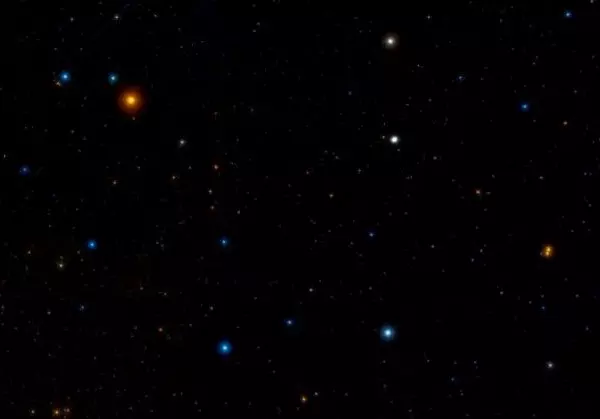
The Keystone, image: Wikisky
Kornephoros – β Herculis (Beta Herculis)
Beta Herculis, or Kornephoros, is the brightest star in Hercules constellation. Its name comes from Greek and means “the club bearer.” Kornephoros has an apparent magnitude of 2.81 and is approximately 139 light years distant.
Beta Herculis is a suspected variable star, with a visual magnitude that can rise to 2.76. It is not a single but a binary star, one with an orbital period of 410 days.
The primary star in the system is a giant belonging to the spectral class G7 IIIa three times as massive as the Sun and with a radius 17 times solar. The other star in the Beta Herculis system has only 90% of the Sun’s mass.
ζ Herculis (Zeta Herculis)
Zeta Herculis is a multiple star with a combined apparent magnitude of 2.81, only 35 light years distant from Earth. It is the brightest of the four stars that form the Keystone asterism.
The primary component in the system is a subgiant star belonging to the spectral class F9 IV, which is orbited by a smaller companion star at a separation of 1.5 arc seconds, with a period of 34.45 years. The primary star has 2.6 times the Sun’s radius and 1.45 times the solar mass. It is more than six times more luminous than the Sun.
Zeta Herculis was once believed to be a member of the Zeta Herculis moving group, a group of stars that share a common origin and are travelling together in space. The group includes Phi-2 Pavonis in Pavo constellation, Zeta Reticuli in Reticulum, 1 Hydrae in Hydra, Beta Hydri in Hydrus, and Gliese 678 in the constellation Ophiuchus, among other stars.
Sarin – δ Herculis (Delta Herculis)
Delta Herculis is another star system in Hercules, composed of between two and five stars. The primary star is a main sequence subgiant belonging to the spectral class A3 IV, twice the size of the Sun. It has an apparent magnitude of 3.126 and is 75.1 light years distant from the Sun.
π Herculis (Pi Herculis)
Pi Herculis is another star in the Keystone asterism. It is a bright giant star belonging to the spectral class K3 II. It has apparent magnitude of 3.15 and is approximately 377 light years distant from the solar system.
Pi Herculis is 4.5 times more massive than the Sun and has about 60 times the solar radius. It is 1,330 times more luminous than the Sun. The star is classified as a variable and shows variations in luminosity by about 0.0054 magnitudes over every 24 hours. It has an unconfirmed substellar companion.
Rasalgethi – α Herculis (Alpha Herculis)
Alpha Herculis is another multiple star system in Hercules. In a telescope, the system can be resolved into two components. Alpha-1 Herculis has an apparent magnitude of 2.1937 and Alpha-2 Herculis, 5.4. The system is approximately 360 light years distant from Earth. The two components are over 500 astronomical units apart and have an orbital period of roughly 3,600 years.
The primary star in the system is a bright red giant belonging to the spectral class M5IIvar (it is a semi-regular variable), and the secondary component has the stellar classification G5III+F2V. Alpha-2 Herculis is a binary star system composed of a yellow giant and a yellow-white dwarf.
The star’s traditional name, Rasalgethi (or Ras Algethi), comes from the Arabic phrase ra’s al-jaθiyy, which means “the head of the Kneeler.” The “head” association comes from ancient times, when the constellation was depicted upside down on star maps. The star’s Latin name, translated from the Arabic, is Caput Ingeniculi.
Marfak Al Jathih Al Aisr – μ Herculis (Mu Herculis)
Mu Herculis is another star system in the constellation. The primary component belongs to the spectral class G5 IV and is only 27.11 light years away from Earth. It has a mass 1.1 times that of the Sun and an apparent magnitude of 3.417.
The secondary component in the system is a binary star with an orbital period of 43.2 years, separated by 286 astronomical units from the primary star. The stars have apparent magnitudes of 10.35 and 10.80.
The star’s traditional name, Marfak Al Jathih Al Aisr, means “the left elbow of the Kneeler.”
Sophian – η Herculis (Eta Herculis)
Eta Herculis is a main sequence star of the spectral type G7.5IIIb. It has an apparent magnitude of 3.487 and is approximately 112 light years distant. It has a mass 2.3 times that of the Sun and 9.8 times the solar radius. It is 50 times more luminous than the Sun. It lies in the northwestern corner of the Keystone asterism. The star is about a billion years old.
Eta Herculis is really a double star. It has a companion, believed to be merely in the same line of sight. The companion has an apparent magnitude of 12.5.
The star’s proper name, Sophian, comes either from the Arabic word for “pure” or from the Greek σοφία, which means “wisdom.”
ξ Herculis – (Xi Herculis)
Xi Herculis belongs to the spectral class K0III and has an apparent magnitude of 3.70. It lies approximately 160 light years from the solar system. It is about 62 times more luminous than the Sun.
γ Herculis (Gamma Herculis)
Gamma Herculis is a spectroscopic binary system. It has an apparent magnitude of 3.75 and is approximately 193 light years distant. The primary star is a giant with the stellar classification of A9III. It is a rapid rotator, with a projected rotational velocity of 135 km/s.
Gamma Herculis has six times the Sun’s radius. It is a semi-regular pulsating variable star, with variations in magnitude ranging from 3.74 to 3.81 over a period of 183.6 days.
ι Herculis (Iota Herculis)
Iota Herculis is a subgiant star belonging to the spectral class B3IV. It has an apparent magnitude of 3.7497 and is approximately 455 light years distant from the Sun. It marks one of Hercules’ feet.
Iota Herculis has 6.5 times the Sun’s mass and 5.3 times the solar radius. It is 2,500 times more luminous than the Sun.
Iota Herculis is not a single star, but a multiple star system. It consists of a spectroscopic binary with a period of 113.8 days, which has two companion stars, one with an orbital period of 60 years and the other one lying further away, with a period of about a million years.
Atia – o Herculis (Omicron Herculis)
Omicron Herculis is another star system in Hercules. It has an apparent magnitude of 3.83 and is approximately 338 light years distant from Earth.
Omicron Herculis has the stellar classification of B9.5V and is about 180 times more luminous than the Sun. It has 3.32 solar masses. The star is classified as an eruptive variable of the Gamma Cassiopeiae type, which means that it is a B-class star that rotates very rapidly, which results in mass outflow.
In three million years or so, Omicron Herculis will be the brightest star in the night sky, with a visual magnitude of -0.4.
Tusizuo – 109 Herculis
109 Herculis is an orange giant with the stellar classification K2III. It has an apparent magnitude of 3.84 and is approximately 119 light years distant from the Sun. It is located halfway between the star Vega in Lyra constellation and Rasalhague in the constellation Ophiuchus.
Rukbalgethi Genubi – θ Herculis (Theta Herculis)
Theta Herculis is a bright giant star of the spectral type K1IIaCN. It is classified as an irregular variable and exhibits variations in magnitude that range from 3.7 to 4.1 over a period of 8 to 9 days. Theta Herculis is approximately 670 light years distant.
The star’s traditional name, Rekbet al Jathih al Aisr, was translated into Latin as Genu Sinistrum Ingeniculi, which means “the left knee of the kneeling man.” The name Rukbalgethi Genubi is derived from the words “ruchbah” (knee) and “genubi” (southern). The star is 2,400 times more luminous than the Sun and has 87 times the solar radius.
Rukbalgethi Shemali – τ Herculis (Tau Herculis)
Tau Herculis is a blue subgiant belonging to the spectral class B5 IV. It has an apparent magnitude of 3.89 and is approximately 310 light years distant from the solar system. The star is 700 times more luminous than the Sun and has 4.9 times the Sun’s mass.
Tau Herculis was the North Pole star around the year 7400 BC and will be the closest bright star to the pole once again in the year 18,400.
The star’s proper name, Rukbalgethi Shemali, means “the northern knee.”
Cujam – ε Herculis (Epsilon Herculis)
Epsilon Herculis is a spectroscopic double, also known as Cujam. It has an apparent magnitude of 3.9111 and is approximately 155 light years distant. It has the stellar classification of A0 V.
Maasym – λ Herculis (Lambda Herculis)
Lambda Herculis has the stellar classification K3.5III. It has an apparent magnitude of 4.402 and is approximately 370 light years distant from the solar system.
English astronomer William Herschel discovered that the solar system as a whole was moving in the direction that was close to the location of Lambda Herculis in the sky.
v Herculis (Nu Herculis)
Nu Herculis is a yellow-white bright giant of the spectral type F2II. It has a visual magnitude of 4.41 and is about 795 light years distant from Earth. The star is five times as massive as the Sun. It has an absolute magnitude of -2.53 and is 8,000 times more luminous than the Sun.
Kajam – ω Herculis (Omega Herculis)
Omega Herculis has the stellar classification B9pCr. It has an apparent magnitude of 4.5821 and is about 240 light years distant. The star’s traditional name, Kajam (sometimes spelled Cajam or Cujam) means “the club.” The star previously had the designation 51 Serpentis.
Marsic – κ Herculis (Kappa Herculis)
Kappa Herculis is a binary star in Hercules. It has an apparent magnitude of 5.1628 and is approximately 390 light years distant. The star is known by its traditional names Marfik, Marfak, or Marsic, all derived from the Arabic Al-Mirfaq, which means “the elbow.” The name Marsic has been formally approved for the star by the International Astronomical Union (IAU).
The primary component is a class G8 giant star with a visual magnitude of 5.00 and the secondary star is a class K1 giant with an apparent magnitude of 6.25. The stars are separated by 27 seconds of arc in the sky.
89 Herculis
89 Herculis belongs to a rare class of stars, the yellow supergiants, with the stellar classification F2Ibe. It has an apparent magnitude of 5.5550 and is approximately 4,000 light years distant from the solar system. The star has a radius 60 times solar and is 7,000-9,000 times more luminous than the Sun.
14 Herculis
14 Herculis is an orange dwarf belonging to the spectral class K0V. It has a visual magnitude of 6.67 and is 57.3 light years distant. Two extrasolar planets were confirmed to be orbiting the star in 2006.
Gliese 651 – HD 154345
Gliese 651 is a dwarf star of the spectral type G8V. It has an apparent magnitude of 6.74 and is 58.91 light years distant.
A wide orbiting planet was discovered around the star in 2006. The planet completes an orbit every nine years.
HD 155358
HD 155358 is a yellow dwarf star of the spectral type G0. It has an apparent magnitude of 7.27 and is approximately 142 light years distant from the Sun. The star is slightly less massive than the Sun and has only 21% of the Sun’s iron-to-hydrogen ratio, which makes it the lowest metallicity star known with a confirmed planet in its orbit.
Two planets are known to be orbiting the star. One is slightly less massive than Jupiter, and the other has half the Jupiter’s mass. The two planets are gravitationally interacting.
HD 147506
HD 147506 is a dwarf star belonging to the spectral class F8V. It has an apparent magnitude of 8.71 and is approximately 370 light years distant from the Sun. The star’s age is estimated to be 2 to 3 billion years.
The star is notable for having the most massive transiting extrasolar planet known in its orbit. The planet, HAT-P-2b, is nine times as massive as Jupiter and orbits the star every 5.6 days.
Gliese 623
Gliese 623 is a binary star 26.3 light years distant from Earth. It is composed of two red dwarfs that orbit each other at a distance of 1.9 astronomical units. The system has an apparent magnitude of 10.27.
Gliese 649
Gliese 649 is a red dwarf with the stellar classification M1.5V. It has a visual magnitude of 9.62 and is 33.72 light years distant. A planet with a mass similar to that of Saturn has been confirmed to be orbiting the star with a period of 598.3 days.
Gliese 661
Gliese 661 is a double star only 19.5 light years distant. It consists of two red dwarfs (spectral types M3 and M3.5, apparent magnitudes of 10.02 and 10.25 respectively). This is the nearest true star system in the constellation Hercules. Only a brown dwarf, WISE 1741+2553, is located closer to us.
GSC 02620-00648 A
GSC 02620-00648 is a binary star in Hercules, approximately 1,400 light years distant from the solar system. The primary component, GSC 02620-00648 A, has 1.18 solar masses and an apparent magnitude of 11.592. It has the stellar classification F8. An exoplanet was discovered orbiting the star in 2006.
GSC 03089-00929
GSC 03089-00929 is a class G main sequence star with an apparent magnitude of 12.4, approximately 1,300 light years distant. It is similar to but slightly cooler than the Sun. An exoplanet was discovered in the star’s orbit in 2007.
Deep sky objects in Hercules
The Great Globular Cluster – Messier 13 (M13, NGC 6205)
Messier 13, also known as the Hercules Globular Cluster or Great Globular Cluster, is a globular cluster that consists of about 300,000 stars located in Hercules constellation. The cluster is 20 arc minutes in size and has an apparent magnitude of 5.8. It is approximately 22,200 light years distant.
The Hercules Globular Cluster was discovered by the English astronomer Edmond Halley in 1714 and included in Messier’s catalogue as Messier 13 on June 1, 1764. The cluster can easily be seen in small telescopes, but is hard to find without visual aids even on a clear night.
M13 is 145 light years in diameter. The brightest star in the cluster is V11, a variable star with a visual magnitude of 11.95.
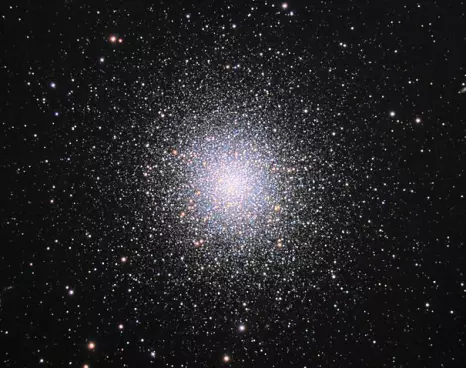
Hercules Globular Cluster (Messier 13), image: Wikimedia Commons/Astrowimp (CC BY-SA 4.0)
M13 has been frequently mentioned in works of science fiction. Most notably, it is the location where the Earth was moved after its supposed destruction in Dan Simmons’ Hyperion Cantos.
The Arecibo message, sent in 1974 to space to let hypothetical extraterrestrials know about life on our planet, was transmitted in the direction of Messier 13, as it was believed that, because star density was higher in that area of space, chances of finding a planet that harbours life were greater too. By the time the message gets there, however, M13 will have moved to a different location.
Messier 92 (M92, NGC 6341)
Messier 92 is another well-known globular cluster in the Hercules constellation. It was discovered by the German astronomer Johann Elert Bode in 1777 and then independently discovered by Charles Messier in 1781.
Messier 92 is relatively bright. It has an apparent magnitude of 6.3 and is approximately 26,700 light years distant from the Sun. It is one of the oldest clusters in the Milky Way, with an estimated age of 14.2 billion years, which is the same age as the universe itself.
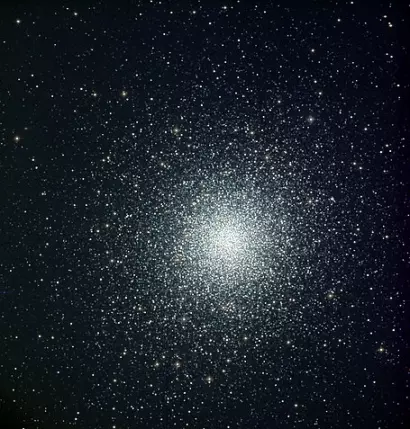
Messier 92, photo courtesy of the Isaac Newton Group of Telescopes, La Palma, author: Daniel Bramich (ING) and Nik Szymanek
Hercules Cluster (Abell 2151)
The Hercules Cluster is a galaxy cluster about 500 million light years from the solar system. It contains about 200 galaxies and is particularly rich in spirals. It is part of the larger Hercules Supercluster (SCI 160).
Abell 39
Abell 39 is a planetary nebula about 3,800 light years away in the constellation Hercules. The nebula is almost perfectly spherical in shape and has a radius of about 2.5 light years, which makes it one of the largest known spherical nebulae.
The central star has an apparent magnitude of 15.5 and the nebula, 13.7.
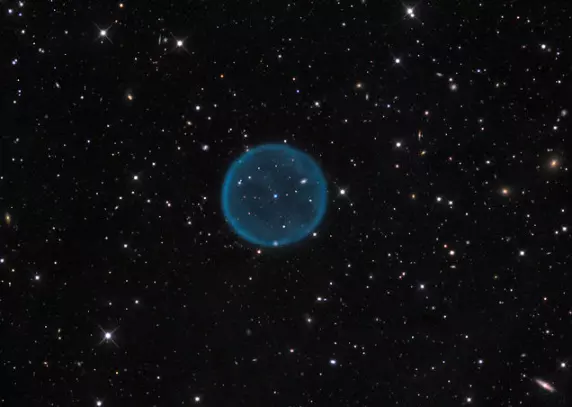
Abell 39, image: Adam Block/Mount Lemmon (CC BY-SA 4.0)SkyCenter/University of Arizona
Abell 2199
Abell 2199 is a cluster of galaxies in Hercules constellation. The brightest member is the elliptical galaxy NGC 6166. The cluster contains over 290 galaxies.
Arp 272 – NGC 6050 and IC 1179
Arp 272 is the name for a pair of colliding spiral galaxies in Hercules, NGC 6050 and IC 1179, located approximately 450 million light years from Earth. The galaxies belong to the Hercules Cluster.
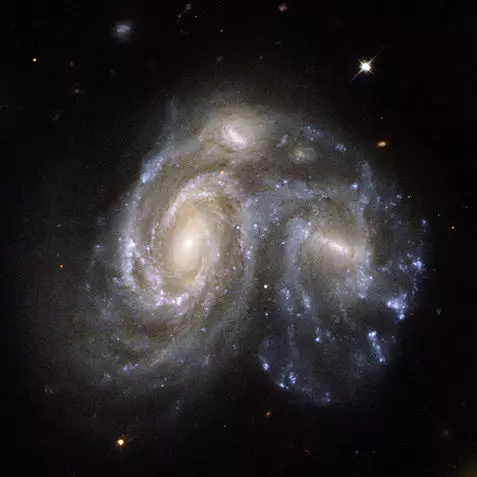
NGC 6050/IC 1179 (Arp 272) is a remarkable collision between two spiral galaxies, NGC 6050 and IC 1179, and is part of the Hercules Galaxy Cluster, located in the constellation of Hercules. The galaxy cluster is part of the Great Wall of clusters and superclusters, the largest known structure in the universe. The two spiral galaxies are linked by their swirling arms. Arp 272 is located some 450 million light-years away from Earth and is the number 272 in Arp’s Atlas of Peculiar Galaxies. This image is part of a large collection of 59 images of merging galaxies taken by the Hubble Space Telescope and released on the occasion of its 18th anniversary on 24th April 2008. Image: NASA, ESA, the Hubble Heritage (STScI/AURA)-ESA/Hubble Collaboration, and K. Noll (STScI)
NGC 6166
NGC 6166 is an elliptical galaxy classified as a supermassive type cD galaxy, which is to say it is a giant elliptical galaxy with a large halo of stars. It is located about 490 million light years away in the Abell 2199 supercluster. A large number of globular clusters are orbiting the galaxy, which is believed to have formed in a series of galaxy collisions.
NGC 6166 has a supermassive black hole at its core and is known to have an active nucleus. The galaxy has a visual magnitude of 12.78.
Hercules A
Hercules A is an active galaxy in Hercules. It appears to be a regular elliptical galaxy, but when imaged in radio waves, there are plasma jets spanning over a million light years around the galaxy.
The galaxy at the centre, 3C 348, has 1,000 times the mass of the Milky Way Galaxy, and the black hole at its centre is almost 1,000 times more massive than the one at the centre of the Milky Way.
Hercules A is 2,100 million light years distant from Earth.
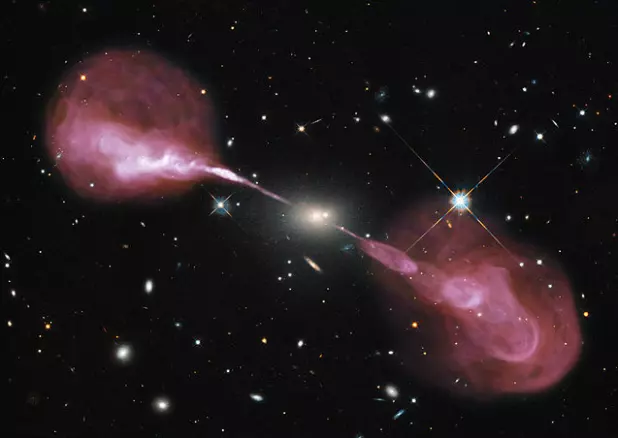
Hercules A – Visible light image obtained by the Earth-orbiting Hubble Space Telescope superposed with a radio image taken by the Very Large Array (VLA) of radio telescopes in New Mexico, USA. Image: NASA, ESA, S. Baum and C. O’Dea (RIT), R. Perley and W. Cotton (NRAO, AUI, NSF), and the Hubble Heritage Team (STScI, AURA)
Turtle Nebula – NGC 6210
The Turtle Nebula (NGC 6210) is another planetary nebula in Hercules. It was discovered by the German astronomer Friedrich Georg Wilhelm Struve in 1825.
The nebula formed when a star similar to the Sun but slightly less massive approached the end of its life and ejected multiple shells of material into space, leaving a hot white dwarf at the core of the newly formed nebula. Our Sun will likely experience the same fate when it approaches the end of its cycle in about five billion years.
NGC 6210 is approximately 6,500 light years distant from Earth.
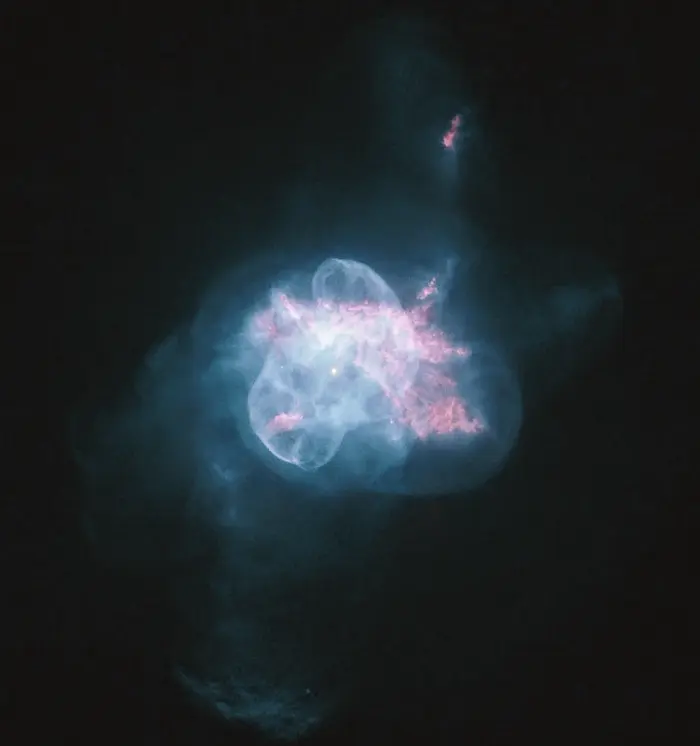
The Turtle Nebula (NGC 6210), image credit: Judy Schmidt (CC BY 2.0)